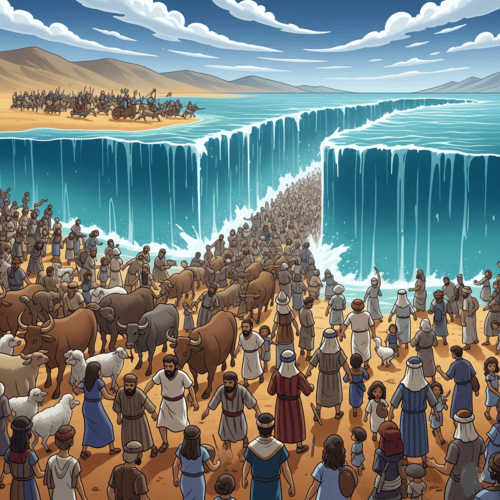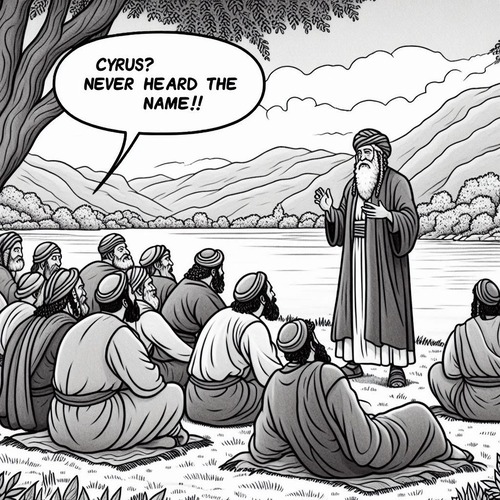BC 1446 or 1250: When Did the Exodus Really Happen?
WHY REFORMED SCHOLARS SUPPORT THE EARLY DATE
Many a critic makes the claim: “Archaeology has disproven the biblical account of the Exodus.” They argue the lack of Egyptian records and minimal archaeological traces in Sinai prove the Bible got its chronology catastrophically wrong. But what if the real problem isn’t the Bible’s reliability—but archaeological assumptions?
The question of Exodus dating isn’t merely academic; it strikes at the heart of the Bible’s authority and God’s covenant faithfulness. Three converging lines of evidence—scriptural chronology, archaeological discoveries, and ancient Near Eastern context—point decisively to 1446 BC as the date of Israel’s departure from Egypt.
THE BIBLICAL FRAMEWORK: TAKING SCRIPTURE SERIOUSLY
The foundation of Reformed chronology rests on 1 Kings 6:1: “In the four hundred and eightieth year after the people of Israel came out of the land of Egypt, in the fourth year of Solomon’s reign over Israel… he began to build the house of the LORD.” This isn’t vague poetry—it’s precise historical data.
Working backward from the well-established date of Solomon’s temple construction (966 BC), the math is straightforward: 966 + 480 = 1446 BC.
Reformed scholars like Eugene Merrill emphasise this calculation gains support from internal Bible chronology. Judges 11:26 speaks of Israel possessing the land for “three hundred years,” requiring substantial time between conquest and Jephthah’s term as judge. The genealogical data in Ruth and Chronicles, combined with the sabbatical year patterns in Leviticus, all converge on the mid-15th century.
Chronologist Rodger Young has demonstrated through detailed analysis that attempts to reinterpret the 480 years as “generations” rather than literal years create more problems than they solve. The Bible’s writers, Young argues, intended precise historical chronology, not symbolic approximations.
ARCHAEOLOGICAL EVIDENCE: THE CASE GROWS STRONGER
Contrary to popular claims, archaeology increasingly supports the early date. Kenneth Kitchen, one of the world’s leading Egyptologists, has shown the Late Bronze Age destruction layers across Canaan align remarkably with Joshua’s conquest campaigns around 1400 BC.
Cities like Hazor show massive destruction and burning precisely when the early date would predict. Kitchen notes the archaeological evidence from Hazor’s destruction “fits the biblical account like a glove” when dated to the 14th century BC. Similarly, Lachish shows destruction evidence that aligns with Joshua 10’s account of the southern campaign.
James K. Hoffmeier, whose expertise in both Egyptology and biblical studies is unparalleled, points to the Merneptah Stele (1213 BC) as crucial evidence. This Egyptian monument mentions “Israel” as an established people in Canaan—the first extra-biblical reference to Israel. But here’s the key: if the Exodus occurred around 1250 BC (the late date), there simply isn’t enough time for Israel to become the established nation that Merneptah encountered. The early date, however, allows for 200+ years of settlement and tribal development.
Bryant Wood’s excavations have revealed the Trans-Jordanian kingdoms of Edom and Moab—whom Israel encountered according to Numbers 20-21—were indeed established during the Late Bronze Age, exactly when the early date would require. The late date theory struggles to explain these encounters, since many scholars believed these kingdoms didn’t exist until the Iron Age.
THE EGYPTIAN CONTEXT: DIVINE TIMING
The political situation of 15th-century Egypt provides the perfect backdrop for the Exodus events. During the reign of Thutmose III (1479-1425 BC), Egypt was preoccupied with extensive military campaigns in Syria-Palestine. The death of this powerful pharaoh created exactly the kind of political instability that would allow a large population to escape Egyptian control.
Hoffmeier’s analysis of Egyptian texts shows the Delta region—where the Israelites were settled—experienced significant disruption during this period. The lack of Egyptian records about the Exodus losses becomes less mysterious when we understand that ancient Near Eastern kings rarely recorded their defeats. Kitchen observes this silence follows established patterns: “Egyptian pharaohs were not in the habit of advertising their disasters.”
ADDRESSING THE OBJECTIONS
The most common objection—“Where’s the archaeological evidence in Sinai?”—reveals a misunderstanding of both nomadic archaeology and Sinai’s environmental conditions. Nomadic populations leave minimal material traces, and the Sinai Peninsula’s acidic soil destroys organic materials within centuries. Merrill notes that expecting to find substantial remains from a 40-year nomadic period in such conditions is archaeologically unrealistic.
The population numbers debate, while interesting, doesn’t affect chronological arguments. Whether the Hebrew word ’eleph means “thousand” or “clan/family unit,” the timing relationships remain unchanged. Reformed scholarship recognises that biblical inspiration encompasses historical accuracy without requiring maximalist interpretations of every detail.
THEOLOGICAL STAKES: GOD’S COVENANT PRECISION
Chronological precision matters because it demonstrates God’s meticulous faithfulness. Genesis 15:13-16 predicted Abraham’s descendants would be in a foreign land for 400 years, then return “in the fourth generation.” Exodus 12:40-41 records the sojourn lasted exactly 430 years. This isn’t mythological approximation—it’s covenant precision.
The early date also allows proper time for the fulfillment of God’s promises regarding Canaan’s inhabitants. Genesis 15:16 stated that the Amorites’ iniquity was “not yet complete.” The early date provides the necessary centuries for this moral deterioration to reach its climax, justifying divine judgment through Israelite conquest.
CONCLUSION: SCRIPTURE VINDICATED
The weight of evidence—biblical, archaeological, and historical—supports the early date for the Exodus. The Bible’s chronological framework, when taken seriously rather than dismissed, aligns remarkably with archaeological discoveries and ancient Near Eastern contexts.
The scholars we cite haven’t simply defended an inherited tradition; they demonstrate how careful biblical exegesis, combined with honest archaeological assessment, vindicates Scripture’s historical reliability. The question isn’t whether the Bible got the Exodus date wrong—it’s whether modern scholarship has been asking the right questions.
As Kitchen concludes in his landmark work On the Reliability of the Old Testament, the biblical account remains “a coherent and credible historical source.” The Exodus happened in 1446 BC, exactly when Scripture indicates.
WHEN DID THE EXODUS REALLY HAPPEN? RELATED FAQs
What about the famous “store cities” of Pithom and Raamses mentioned in Exodus 1:11? The cities of Pithom and Raamses don’t undermine the early date—they actually support it. Archaeological evidence shows both cities were major construction projects during the 18th Dynasty (1550-1295 BC), perfectly aligning with the early date timeline. The name “Raamses” likely reflects later editorial updating of an older place name, a common practice in ancient manuscripts to help readers identify locations by their contemporary names.
- How do we explain the apparent lack of Hebrew slaves in Egyptian records from this period? Egyptian records primarily focused on royal achievements and religious matters, not detailed census data of foreign workers. Semitic populations are actually well-documented in Egypt during the Middle and New Kingdoms, often serving in construction projects. Additionally, many papyrus records from the Delta region—where the Israelites lived—have been destroyed by humidity and flooding over the millennia, creating significant gaps in our Egyptian documentation from this very area.
- What happened to Pharaoh’s army in the Red Sea, and why don’t Egyptian records mention this disaster? The loss of Pharaoh’s chariot force would have been a devastating military and economic blow to Egypt. However, ancient Near Eastern royal inscriptions follow a strict convention of recording only victories and divine blessings, never defeats or disasters. The political chaos that followed such a military catastrophe would explain Egypt’s reduced influence in Canaan during the Late Bronze Age, precisely when Israel was settling the land.
How does the early date fit with Egyptian pharaohs like Amenhotep II and Thutmose IV? The early date places the Exodus during the reign of Amenhotep II (1427-1401 BC), whose inscriptions notably avoid mentioning military campaigns in his later years—unusual for a typically boastful pharaoh. His successor Thutmose IV’s famous “Dream Stele” suggests he wasn’t the expected heir, possibly indicating dynastic disruption. This fits perfectly with the death of Egypt’s firstborn sons, including the crown prince, as described in Exodus 12:29.
- What about the Israelites’ bronze-working skills mentioned in the wilderness—wouldn’t this require contact with settled peoples? The bronze-working techniques described in Exodus actually align perfectly with Late Bronze Age technology (1500-1200 BC). The Israelites had lived in Egypt for centuries, absorbing advanced metallurgical knowledge from one of the ancient world’s most sophisticated civilisations. Additionally, the Midianites—whom Israel encountered in the wilderness—were skilled metalworkers who controlled important copper mining operations in the Arabah region south of the Dead Sea.
- How do we reconcile the 40-year wilderness wandering with the apparent speed of ancient Near Eastern military campaigns? The 40-year period wasn’t primarily about travel time—it was divine discipline for the generation that refused to enter Canaan after the negative report of the ten spies (Numbers 14:26-35). Archaeological surveys show that the Sinai Peninsula and southern Jordan regions had sufficient water sources and seasonal grazing areas to support large nomadic populations. The wandering pattern follows established ancient nomadic routes between oases and seasonal pastures.
Why do some evangelical scholars still prefer the late date (1250 BC) if the evidence favours 1446 BC? Many evangelical scholars adopted the late date during the mid-20th century when it seemed to align better with then-current archaeological theories about Canaanite city destructions. However, as archaeological methods have improved and more sites have been excavated, the evidence increasingly favours the early date. Some scholars remain hesitant to abandon positions they’ve long defended, while others are genuinely working through the complex interplay of biblical chronology, archaeology, and ancient Near Eastern history.
WHEN DID THE EXODUS REALLY HAPPEN? OUR RELATED POSTS
Editor's Pick

The One Man Mystery in Acts 17:26: Is It Adam Or Noah?
When the Apostle Paul stood before the philosophers at Mars Hill, he delivered an insightful statement about human unity: “And [...]

Megiddo Or Jerusalem: Where Did King Josiah Die?
Recent archaeological discoveries at Tel Megiddo continue to reveal evidence of Egyptian military presence during the late 7th century BC, [...]

Losing Your Life Vs Wasting It: How Are the Two Different?
AND WHY DID JESUS PRAISE THE FORMER? Jesus spoke one of the most perplexing statements in Scripture: “For whoever wants [...]

Can Christians Be Demon Possessed? What the Bible Teaches
Perhaps you’ve witnessed disturbing behavior in a professing Christian, or you’ve struggled with persistent sin and wondered if something darker [...]

Sacred Fury: What Christ’s Temple Cleansing Truly Means
Mark 11 records the crack of a handmade whip that echoed through the temple corridors. Tables crashed to the ground, [...]

Did Jesus Cleanse the Temple Twice?
OR DID JOHN DISAGREE WITH THE SYNOPTICS ON TIMING? One of sceptics’ favourite "gotcha" questions targets what they see as [...]

Self-Authentication: Why Scripture Doesn’t Need External Validation
"How can the Bible prove itself? Isn't that circular reasoning?" This objection echoes through university classrooms, coffee shop discussions, and [...]

Do Christians Need Holy Shrines? Why the Reformed Answer Is No
Walk into a medieval cathedral and you'll encounter ornate shrines, gilded reliquaries, and designated "holy places" where pilgrims gather to [...]

I Want To Believe, But Can’t: What Do I Do?
"I want to believe in God. I really do. But I just can't seem to make it happen. I've tried [...]

BC 1446 or 1250: When Did the Exodus Really Happen?
WHY REFORMED SCHOLARS SUPPORT THE EARLY DATE Many a critic makes the claim: “Archaeology has disproven the biblical account [...]
SUPPORT US:
Feel the Holy Spirit's gentle nudge to partner with us?
Donate Online:
Account Name: TRUTHS TO DIE FOR FOUNDATION
Account Number: 10243565459
Bank IFSC: IDFB0043391
Bank Name: IDFC FIRST BANK





